| The Backyard Livestock and Poultry Surveys (BLPS) and the Commercial Livestock and Poultry Surveys (CLPS) are two (2) major surveys which aim to determine and measure the inventory, disposition, and volume of production of farm animals from the backyard and commercial livestock and poultry industry. |
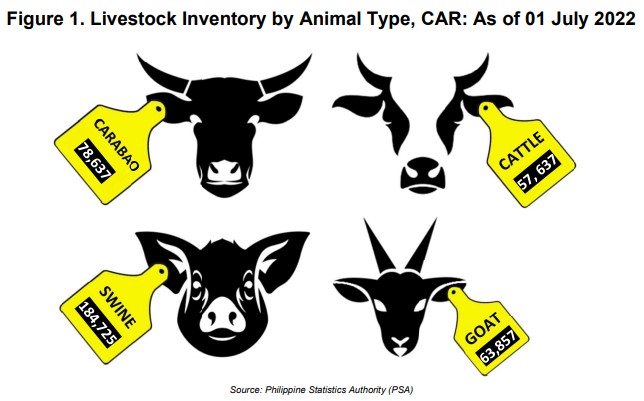
Swine comprises most of livestock inventory in Cordillera
- Among the four animal types of livestock, swine had the largest number recorded with 184,725 heads or 48.0 percent of the region’s total livestock population.
- Carabao recorded the second largest livestock inventory with 78,637 heads or 20.4 percent, followed by goat with 63,857 heads, and cattle with 57,637 heads equivalent to 16.6 percent and 15.0 percent of the region’s total livestock population, respectively.
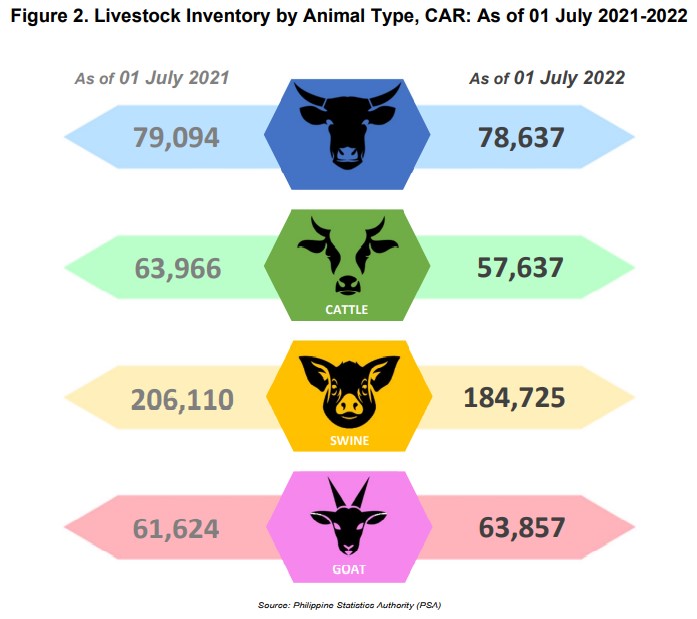
All livestock animals inventory in Cordillera decrease except goat
- As of 01 July 2022, the total goat inventory in Cordillera reached 63,857 heads. This was 3.6 percent higher than the previous year’s July inventory count of 61,624 heads.
- In terms of 01 July year-on-year growth rate, swine recorded a decline with -10.4 percent or a decrease of 21,385 heads.
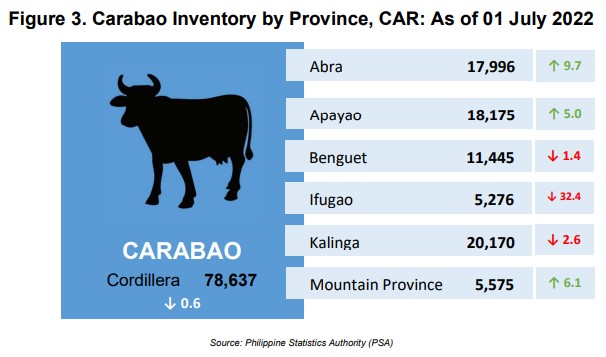
Ifugao records lowest growth in carabao inventory
- As of 01 July 2022, the total carabao inventory in Cordillera reached 78,637 heads. This was 0.6 percent lower than the previous year’s July count or a decrease of 457 heads.
- With 32.4 percent decline rate, Ifugao recorded the steepest year-on-year July inventory decline among the provinces of Cordillera, with a decrease of 2,530 heads.
- In terms of share, the top provinces were Kalinga, Apayao, and Abra with a combined contribution of 71.7 percent to the region’s total carabao population.
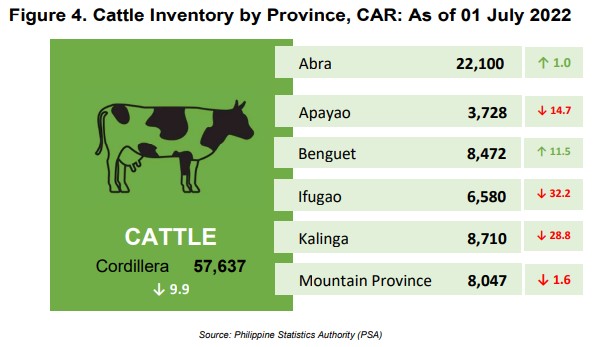
Only Benguet and Abra record positive growth in cattle inventory
- As of 01 July 2022, the total cattle inventory in Cordillera reached 57,637 heads. This was 9.9 percent lower than the previous year’s July count or a decrease of 6,329 heads.
- Benguet and Abra recorded positive growth of 11.5 percent and 1.0 percent or an increase of 876 heads and 216 heads, respectively, while the rest of the provinces went down from its previous year-on-year July inventory.
- In terms of share, the top provinces were Abra, Kalinga, and Benguet with a combined contribution of 68.2 percent to the region’s total cattle population.
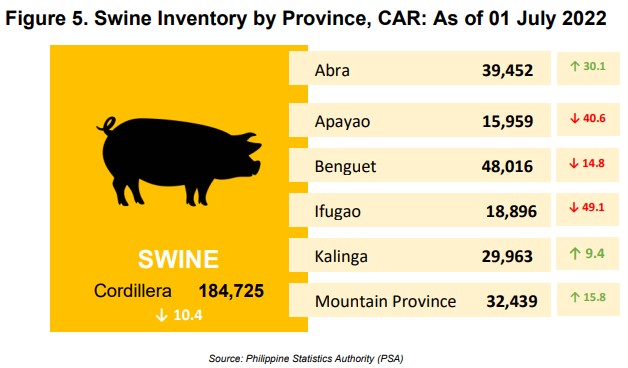
Ifugao records lowest growth in swine inventory
- As of 01 July 2022, the total swine inventory in Cordillera reached 184,725 heads. This was a decrease of -10.4 percent compared to the previous year’s July count, equivalent to a decrease of 21,385 heads.
- With 49.1 percent decline rate, Ifugao recorded the lowest year-on-year July inventory decline among the provinces of Cordillera, with a decrease of 18,213 heads.
- In terms of share, the top provinces were Benguet, Abra, and Mountain Province with a combined contribution of 64.91 percent to the region’s total swine population.

All provinces of Cordillera listed an increase in goat inventory except Kalinga
- As of 01 July 2022, the total goat inventory in Cordillera reached 63,857 heads. This was 3.6 percent higher than the previous year’s July count or an increase of 2,233 heads.
- Kalinga showed a decline of -53.2 percent or a decrease of 1,689 heads, while the rest of the provinces went up from its year-on-year July inventory.
- In terms of share, the top provinces were Abra, Benguet, and Ifugao with a combined contribution of 88.10 percent to the region’s total goat population.
VILLAFE P. ALIBUYOG
Regional Director
--------------------------------------------
Technical Notes
Livestock – refers to farm animals kept or raised for consumption, work or leisure. In general, poultry is separated as a distinct group of farm animals. For purposes of censuses and surveys, livestock covers only those that are tended and raised by an operator.
Livestock Production – refers to the volume of indigenous (locally-raised) animals disposed for slaughter plus animals exported or shipped-out for slaughter both in live weight equivalent.
Livestock Inventory – refers to the actual number of livestock animals, in heads, present in the farm as of a specific reference date.
Carabao - is a domestic swamp-type water buffalo native to the Philippines.
Cattle – is a large ruminant animal with horns and cloven hoofs, herbivores, domesticated for meat or milk, or as beasts of burden.
Goat – is a hardy domesticated ruminant animal that has backward curving horns, (in the male) a beard, and, domesticated for milk and meat.
Swine – a non-ruminant, cloven-footed animal belonging to family suidae with simple stomach, having a snout, large number of mammary glands, thin skin, and heavy bristles

